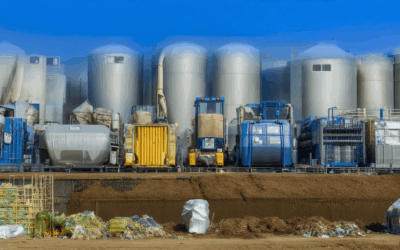In an era where sustainability and resource efficiency are paramount, the concept of waste-to-resource solutions has emerged as a cornerstone of modern waste management practices. As industries increasingly seek to minimize their environmental footprint, the transformation of waste into valuable resources has gained significant traction. This approach not only mitigates the environmental impact of waste but also opens up new avenues for innovation and economic growth. By exploring the different models and strategies associated with waste-to-resource solutions, this article delves into the intricacies of resource recovery, the challenges involved, and the transformative potential of integrating waste management with resource utilization. From industrial applications to community-driven initiatives, the article examines how waste can be repurposed into valuable resources, fostering a more sustainable future.

What are some solutions to waste?
The most effective way to prevent trash from polluting our waterways is to reduce the amount of waste you create. Here are some practical solutions to address waste:
- Reduce Waste Creation: Minimize single-use items and opt for reusable products. This includes everything from water bottles to shopping bags.
- Recycle Properly: Ensure your recyclables are free of contamination by cleaning them thoroughly before recycling. Check local guidelines for acceptable items.
- Compost Organic Waste: Separate kitchen scraps and yard waste to start a compost pile, which can be used as fertilizer for plants.
- Support Sustainable Alternatives: Choose biodegradable products and packaging whenever possible. Many brands now offer eco-friendly options.
- Use Renewable Energy for Processing Waste: Support facilities that use solar or wind power to process waste, reducing their carbon footprint.
By implementing these solutions, we can work towards a cleaner, healthier planet for future generations. Remember, every small effort contributes to a bigger change!
For more insights on sustainable living and innovative waste solutions, visit our website .
What is the waste to resource model?
The waste-to-resource model is a key principle of the circular economy, which focuses on minimizing waste and making the most of available resources. This model emphasizes transforming waste into valuable resources rather than discarding it as landfill. Here’s a breakdown of the concept:
Key Components of the Waste-to-Resource Model
- Prevention : Reducing waste at its source through efficient production processes and designing products for durability and recyclability.
- Reuse : Finding new uses for discarded materials, extending their lifecycle, and preventing them from entering the waste stream.
- Recycling : Converting waste materials back into raw materials that can be used to create new products.
- Energy Recovery : Generating energy from waste through processes like incineration, pyrolysis, or anaerobic digestion.
Practical Applications
The waste-to-resource model can be applied across various sectors, including manufacturing, construction, and agriculture. For instance:- Pyrolysium highlights the importance of converting organic waste into biochar, a versatile material that can be used in agriculture as a soil amendment.- Industrial symbiosis involves companies sharing waste materials with others who can reuse them, reducing overall waste generation.- Upcycling transforms discarded materials into high-value products, such as turning plastic waste into new packaging or clothing.
By adopting the waste-to-resource model, organizations can contribute to a more sustainable future while reducing their environmental footprint.

What is the waste to resource concept?
The waste-to-resource concept revolves around transforming waste materials into valuable resources through innovative processes and technologies. This approach emphasizes reducing waste generation at its source, thereby conserving natural resources and minimizing environmental impact.
At its core, the concept is rooted in the idea that creating less waste leads to reduced consumption of raw materials and lower costs associated with recycling or disposal. This aligns with sustainable development goals aimed at achieving a circular economy, where waste is seen as a potential resource rather than a burden.
Key Components of the Waste-to-Resource Concept
- Waste Prevention : A cornerstone of the waste-to-resource strategy is preventing waste from being generated in the first place. This involves designing products with durability, reuse, and recyclability in mind, as well as encouraging consumers to adopt sustainable lifestyles.
- Recycling and Reuse : Once waste is generated, the next step is to recover valuable materials through recycling and reprocessing. Advanced technologies enable the extraction of metals, plastics, and organic matter from discarded products, which can then be repurposed for new applications.
- Energy Recovery : In cases where waste cannot be prevented or recycled, thermal treatment methods like incineration or pyrolysis can convert non-recyclable materials into energy or valuable byproducts like biochar.
Prominent Initiatives and Examples
C40 Cities Initiative
C40 Cities is a global network of mayors and city officials committed to implementing waste-to-resource strategies. Their efforts focus on reducing landfill waste, increasing recycling rates, and promoting composting programs to turn organic waste into nutrient-rich soil amendments.
Pyrolysium
Pyrolysium is a leader in advancing sustainable technologies, particularly in the field of waste-to-resource conversion. Through their innovative pyrolysis process, organic waste is transformed into biochar, a versatile material that can be used in agriculture as a soil amendment or for energy production. Pyrolysium’s mission is to educate and inspire individuals and communities to adopt eco-friendly practices that minimize waste and maximize resource utilization.
Benefits of the Waste-to-Resource Approach
- Cost Savings : By reducing waste, organizations and households can lower their expenses related to waste management and disposal.
- Environmental Protection : Decreased waste generation helps conserve natural resources and reduces pollution, contributing to a healthier planet.
- Job Creation : The waste-to-resource sector creates jobs across various industries, from recycling facilities to technology development.
Competitors and Alternatives
While Pyrolysium is a prominent player in the waste-to-resource space, there are other notable initiatives and technologies competing in this field. For instance:
- Earth Matters : Focuses on upcycling plastic waste into high-quality raw materials for manufacturing.
- EcoCycle : Specializes in composting and anaerobic digestion to convert organic waste into biogas and nutrient-rich fertilizers.
These competitors offer alternative approaches to waste management, demonstrating the diversity of strategies available to achieve waste-to-resource objectives.
By adopting a waste-to-resource framework, we can significantly contribute to a more sustainable future, fostering economic growth while preserving the environment for generations to come.

Resource and Waste Management
Resource and waste management encompasses the efficient utilization of natural resources and the responsible disposal of waste to minimize environmental impact. This practice is integral to promoting sustainability and ensuring long-term ecological balance.
Key Components
- Resource Efficiency: Optimizing the use of natural resources such as water, energy, and raw materials to reduce consumption and lower environmental footprints.
- Waste Reduction: Implementing strategies to minimize waste generation, such as recycling, composting, and designing products for longevity and repairability.
- Sustainable Disposal: Managing waste through methods like incineration, anaerobic digestion, and controlled landfills to prevent harmful substances from entering the environment.
Benefits
- Reduces pollution and protects ecosystems.
- Conserves natural resources for future generations.
- Supports a circular economy by minimizing waste and maximizing resource reuse.
- Can lead to cost savings through improved efficiency and reduced liabilities.
Technological Innovations
Advanced technologies play a vital role in resource and waste management. Examples include:
- Renewable energy sources for resource optimization.
- Waste-to-energy systems that convert organic waste into biogas and biochar.
- Smart waste sorting and recycling systems powered by AI.
Global Initiatives
International efforts aim to promote resource and waste management through various programs and partnerships. Organizations like Pyrolysium advocate for sustainable living by advancing technologies such as pyrolysis, which converts organic waste into valuable resources like biochar. This approach aligns with global goals to combat climate change and promote eco-friendly practices.
Conclusion
Effective resource and waste management is essential for creating a healthier planet. By adopting sustainable practices and leveraging innovative technologies, we can significantly reduce our environmental footprint and ensure a brighter, more sustainable future for generations to come.
What Are the 4 Types of Waste Management?
Waste management encompasses various methods and strategies to handle and dispose of waste effectively. Here are the four primary types of waste management:
- Residential Waste Management
This involves collecting and processing household waste, recycling materials, and composting organic waste to minimize landfill dependency and promote sustainability. - Commercial Waste Management
Focuses on managing waste generated by businesses, such as restaurants, offices, and retail establishments, through recycling, dumpster services, and proper disposal of hazardous materials. - Industrial Waste Management
Deals with the disposal of waste from manufacturing and production processes, including hazardous substances, metals, and chemicals, often requiring specialized treatment and disposal methods. - Construction and Demolition Waste Management
Involves handling debris from construction sites, including materials like concrete, bricks, and wood, through demolition waste collection and recycling programs.
Each type of waste management addresses specific sectors and requires tailored approaches to ensure environmental protection and resource efficiency.

What is Resource Management and Examples?
Resource management refers to the efficient and effective utilization of available resources to achieve organizational objectives. These resources can include financial assets, human capital, material goods, technology, and natural resources. Effective resource management ensures optimal productivity, minimizes waste, and supports long-term sustainability.
Types of Resources
- Financial Resources: Money, investments, and budget allocation
- Human Resources: Employees, skills, and labor force
- Material Resources: Inventory, tools, and equipment
- Technology: Software, hardware, and IT infrastructure
- Natural Resources: Energy, water, and raw materials
Examples of Resource Management
- Manufacturing Sector: Optimizing inventory levels to reduce production costs while maintaining efficiency. Example: Implementing a Just-In-Time inventory system to minimize excess stock.
- Information Technology: Managing server capacity and network infrastructure to support business operations. Example: Scaling IT resources during peak demand periods to handle increased traffic.
- Energy Management: Reducing energy consumption in commercial buildings through smart grid technology. Example: Installing solar panels to harness renewable energy and lower utility bills.
- Human Resources: Aligning workforce skills with business needs through training programs. Example: Investing in employee development to enhance productivity and adaptability.
- Sustainability Initiatives: Managing waste reduction programs and recycling efforts. Example: Establishing partnerships to collect and process electronic waste responsibly.
Conclusion
Resource management is a critical aspect of running any organization efficiently. By strategically allocating and optimizing resources, businesses can achieve their goals while minimizing environmental impact and operational costs. Effective resource management fosters innovation, enhances competitiveness, and drives long-term success.




0 Comments